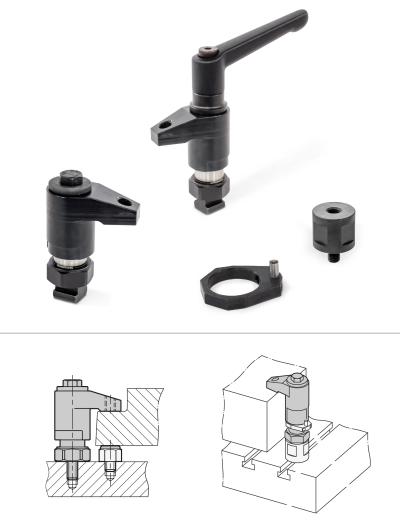
In tool and fixture manufacturing, quick workpiece changes are generally required even when space is tight. For such situations, JW Winco offers the down-thrust clamp as a new, compact and – above all – universal clamping element. With a clamping arm that swivels away to the side, workpieces can be fixed in the correct position quickly and securely without getting in the way.
The new down-thrust clamp GN 9192 made from case-hardened steel can be fastened to a machine table with T-slots or to a fixture plate. The clamping arm can then be swiveled by hand and positioned over the inserted workpiece in any position. Turning and tightening the clamping screw or the adjustable hand lever lowers the clamping arm to hold the workpiece in place. After release, workpieces can be removed again from above just as quickly and easily once the clamping arm has been swiveled to the side – even when space is tight.
To enable precise and highly repeatable positioning of the clamping point, the standard part specialist JW Winco offers the positioning ring GN 9192.2 as an accessory to the down-thrust clamp. With the help of a positioning pin, the swivel range of the clamping element is limited to 110° to the right and left so that the clamping arm can always be returned to the exact same clamping position during repeated movements. The positioning ring is fastened to the guide element of the down-thrust clamp using pressure screws, and it decreases the stroke length of the clamping element by its own height.
JW Winco has also added the height-adjusting cylinder GN 9192.3 to its product range as another accessory for the down-thrust clamp. This is used to increase the clamping height of the standard part. Height-adjusting cylinders can also be used in combination with positioning elements and clamping pads to position contact points at a greater distance from the reference surface.
Contact Details
Related Glossary Terms
- fixture
fixture
Device, often made in-house, that holds a specific workpiece. See jig; modular fixturing.
- turning
turning
Workpiece is held in a chuck, mounted on a face plate or secured between centers and rotated while a cutting tool, normally a single-point tool, is fed into it along its periphery or across its end or face. Takes the form of straight turning (cutting along the periphery of the workpiece); taper turning (creating a taper); step turning (turning different-size diameters on the same work); chamfering (beveling an edge or shoulder); facing (cutting on an end); turning threads (usually external but can be internal); roughing (high-volume metal removal); and finishing (final light cuts). Performed on lathes, turning centers, chucking machines, automatic screw machines and similar machines.
